Are you ready to embark on an epic solo hiking adventure? Look no further than the W Trek in Torres Del Paine, Chile. This comprehensive guide will equip you with everything you need to conquer the one of the best hikes in Patagonia. Whether you’re a seasoned hiker or new to the trail, we’ll ensure you have all the information you need for solo hiking the W Trek. From crafting your perfect itinerary to packing the essentials and navigating the logistics, let’s prepare you for the journey of a lifetime.
This article contains affiliate links from the Amazon Associate and Travelpayouts programs. Wild Travel Tales will earn from qualifying purchases, at no extra cost to you.
Key Takeaways
- Day 1: Puerto Natales to Grey (bus, ferry, 11km walk)
- Day 2: Grey to Paine Grande (11km), plus optional glacier hike
- Day 3: Paine Grande to Francés/Los Cuernos (21km)
- Day 4: Francés/Los Cuernos to El Chileno/Central (18km)
- Day 5: El Chileno/Central to Mirador Las Torres to Puerto Natales (9km)
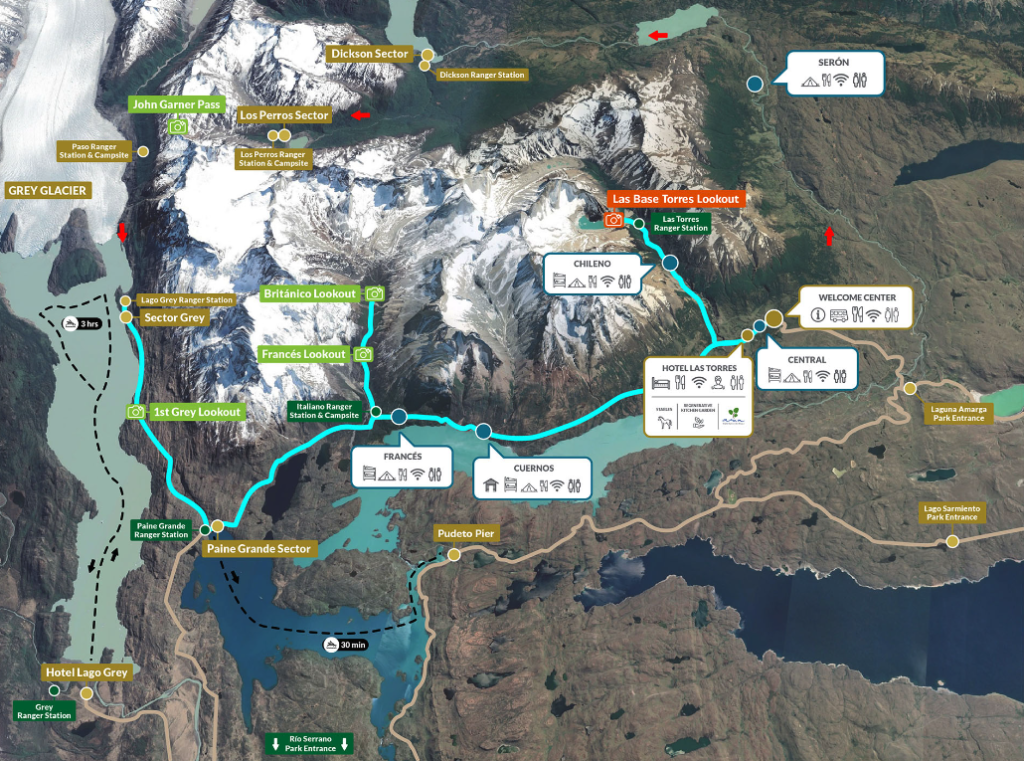
Checklist to Hike the W Trek without a Guide
This post explains everything you need to do to plan your W Trek adventure in detail. Before we get started, here is a simple checklist you will need to check-off.
- Book your accommodation via Torres Hike, or directly via Vertice and Las Torres – you need to book as early as possible, as it it can book out!
- Book your entrance ticket to Torres del Paine National Park online
- Pack proper equipment and food
- Book your return bus ticket from Puerto Natales to Torres del Paine National Park
- Ensure you have at least $28,000 pesos in cash ($25,000 pesos for the ferry, $3,000 pesos for the shuttle bus) as well as extra for any additional purchases you may want to make while in the park (e.g., snacks, drinks, meals, etc) – you should definitely bring extra money, just in case!
Where is the W Trek Located?
The famous W Trek is located in Torres Del Paine National Park, nestled in the southern reaches of Chilean Patagonia. This UNESCO Biosphere Reserve boasts pristine landscapes, dramatic peaks, and crystal-clear lakes, making it a dream destination for adventurers like you. The name “W Trek” originates from the distinct W-shaped path you’ll follow through the park, which offers a curated experience of Patagonia’s finest offerings.
When is the Best Time to Do the W Trek?
Planning your visit to Torres Del Paine is a crucial first step. While the park is open year-round, selecting the best time to hike the W Trek can greatly impact your experience. This will mostly come down to your preferences and desired experience.
Here’s a breakdown of your options:
- Shoulder Seasons: For milder weather and fewer crowds, consider hiking during late October to early November or late March to early April.
- Peak Season: If you crave the vibrant colours of Patagonian spring or the lushness of summer, be prepared for larger crowds during the peak season from November to March.
Where to Stay on the W Trek?
The W Trek offers a range of accommodation options to suit various preferences and budgets:
- Camping: Experience the wild by camping under the stars. This is a budget-friendly option for adventurous backpackers.
- Refugios: For a more comfortable stay, opt for refugios, which are similar to hostels. They offer a warm and cozy atmosphere after a long day of hiking and often provide shared facilities.
Camping vs Refugios on the W Trek
For those with an adventurous spirit and a desire to be as close to nature as possible, camping is an excellent choice. It is also substantially cheaper than staying in a refugio, which is a great way to bring down the cost of hiking the W Trek.
Many campsites are strategically located right outside the doors of refugios, granting you easy access to their facilities. This means you can enjoy the perks of refugios, such as meals and hot showers, while still savouring the authenticity of sleeping under Patagonia’s star-studded skies. It’s worth noting that you’ll need to carry your camping gear, including a suitable tent, sleeping bag, and cooking equipment, to ensure a comfortable stay. However, there are premium campsite options available with a pre-erected tent provided!
On the other hand, if you prefer a bit more comfort and convenience, the refugios are ready to welcome you. These cozy mountain lodges provide dormitory-style accommodation and shared facilities, including dining areas and hot showers. Staying in a refugio means you don’t have to lug heavy camping gear with you, allowing for a lighter backpack. However, it will make hiking the W Trek more expensive.
Booking Campsites & Refugios for the W Trek
As one of Patagonia’s most sought-after hikes, it can be difficult to secure campsites or refugio beds for the days you want. It is essential that you book your accommodation in advance (as early as possible), especially during the peak season. It is not uncommon for campsites and refugios to book out.
The campsites and refugios at different points along the W Trek are operated by two different companies, Vertice and Las Torres (formerly Fantastico Sur). You have two different options to book these sites:
- Book via Torres Hike, a platform which aggregates availability from both Vertice and Las Torres. All you need to do is enter your planned dates, the direction of your hike and which type of accommodation you want, and the website will allow you to make one single booking (instead of coordinating separate bookings via both Vertice and Las Torres). This will save you lots of time compared to the second option…
- Make reservations with Vertice and Las Torres directly, via their websites. This option requires you to ensure the availability of campsites offered by both providers aligns with your planned itinerary in the correct order of your hike, then booking each night of accommodation on each company’s separate website. Meticulous planning is necessary.
Why would anyone book through separate websites when it is all collated in one platform via Torres Hike? Good question. Unfortunately, Vertice and Las Torres only allocate a limited number of campsites for purchase via Torres Hike. And because Torres Hike is a far easier process, these sites will book out more quickly than direct bookings. So, if Torres Hike does not show any availability for the dates you want to hike the W Trek, you may be able to book under your original itinerary if you book via Vertice and Las Torres.
There are often different options you could book for each night, depending on the distance you plan to cover each day. Below are the campgrounds along the W Trek in order.
- Refugio and Camping Paine Grande (Vertice Patagonia)
- Refugio and Camping Grey (Vertice Patagonia)
- Domes and Camping Francés (Las Torres)
- Refugio and Camping Los Cuernos (Las Torres)
- Refugio and Camping Torres Central (Las Torres)
- Refugio and Camping El Chileno (Las Torres)
You will only stay at 3 or 4 of the campsites, depending on how many days you plan in your itinerary. Plan ahead, consider your preferences for camping or staying in refugios, and make those reservations promptly to guarantee a smooth and enjoyable W Trek experience.

How Difficult is the W Trek?
The difficulty of the W Trek can vary along its route. Understanding its challenges is paramount for a successful journey. Here’s an in-depth look at what you can anticipate.
Physical Fitness: The W Trek is considered moderately strenuous, making it accessible to hikers with a range of fitness levels. While it doesn’t require you to be an elite athlete, it’s essential to have a reasonable level of physical fitness. This includes the ability to hike for several hours a day, navigate uneven terrain, and endure uphill climbs and descents. Prior conditioning and cardiovascular endurance can significantly enhance your experience.
Changing Trail Conditions: Patagonia’s weather is notorious for its unpredictability. Be prepared for rapidly changing conditions that can range from sunny and pleasant to windy, rainy, or even snowy. Proper clothing and gear are crucial to adapt to these changes and ensure your safety and comfort.
Route Options: The W Trek offers flexibility in choosing your direction, whether east-to-west or west-to-east, each with its own highlights. Starting from the east provides a dramatic introduction to the famous Torres Del Paine, while the west-to-east route saves the iconic towers for a breathtaking finale. Your choice can influence the level of challenge and the order in which you encounter terrain difficulties.
Mental Preparedness: Apart from physical stamina, mental preparedness is equally vital. The W Trek can be mentally demanding due to its length and the ever-changing Patagonian weather. Staying positive, focused, and patient in adverse conditions or challenging moments will contribute significantly to your overall experience.
Trail Easing Tips: To make your hike more manageable, consider using hiking poles for stability, wear appropriate footwear with ankle support, and break in your hiking boots before the trip. Additionally, packing smartly, including essential items, such as moleskin for blisters, sunscreen, and extra layers, can help ease your journey.
Prepare mentally and physically for the challenges that await you, and you’ll conquer the trek with confidence.
What Should I Pack for the W Trek?
The key to a successful W Trek is packing the right gear. Here’s a list of essentials.
Camping Gear:
- Sleeping bag (rated for 20 degrees or less)
- Sleeping mat
- Gas stove/jet boil
- Gas canister
- Lightweight bowl/plate/utensils
- Travel towel
- Tent
Clothing:
- Layers are essential. Pack a handful of lightweight shirts/base layers.
- Fleece jacket
- Waterproof jacket
- Waterproof gloves
- Water-resistant pants
- Several pairs of socks
- Hiking boots
- Camp/refugio slippers
- Warm hat
- Sunglasses
- Comfortable camp clothing
- Pyjamas
Hiking Gear:
- Consider hiking poles for stability
- Headlamp
- Sunscreen
- Moleskin for blisters
- Refillable water bottle
- First-aid kit
With the right gear in your backpack, you’ll be prepared for whatever Patagonia throws your way.
How Long Does it Take to Hike the W Trek?
The W Trek offers flexibility in both duration and direction. You can choose to complete it in 4, 5, or 6 days, depending on your pace and preferences. A fit hiker can complete the route in 4 days with careful planning. Choosing a 5-day itinerary can provide some extra time to explore side trails and enjoy the scenery, without rushing to meet longer distances. If you are new to hiking and want to take it easy, make it a 6-day adventure.
How Do I Get to the W Trek?
The best way to get to Torres del Paine National Park is from Puerto Natales, a charming town that serves as the main entry point to the national park. Wherever you are, you need to get here!
Travellers can now enjoy the convenience of direct flights from Santiago to Puerto Natales, thanks to the Teniente Julio Gallardo Airport (PNT), with a flight duration of approximately 3 hours. After landing, a short 10-minute taxi ride will swiftly transport you from the compact airport to the heart of downtown Natales, where the majority of hotels and accommodations are thoughtfully situated for your ease and comfort.
If you need other options, you can also catch a flight to Punta Arenas and take a bus to Puerto Natale. We recommend booking your bus tickets in advance, especially if you’re aiming for early morning departures, as they can fill up quickly.
Stay overnight in Puerto Natales to rest and prepare for your adventure. The town offers various accommodation options, and it’s an excellent opportunity to stock up on supplies, including any last-minute gear or provisions you might need for your trek. After a peaceful night’s rest and final preparations, you can embark on the short journey from Puerto Natales to the enchanting wilderness of Torres Del Paine National Park, where the W Trek awaits, ready to unveil its natural wonders.
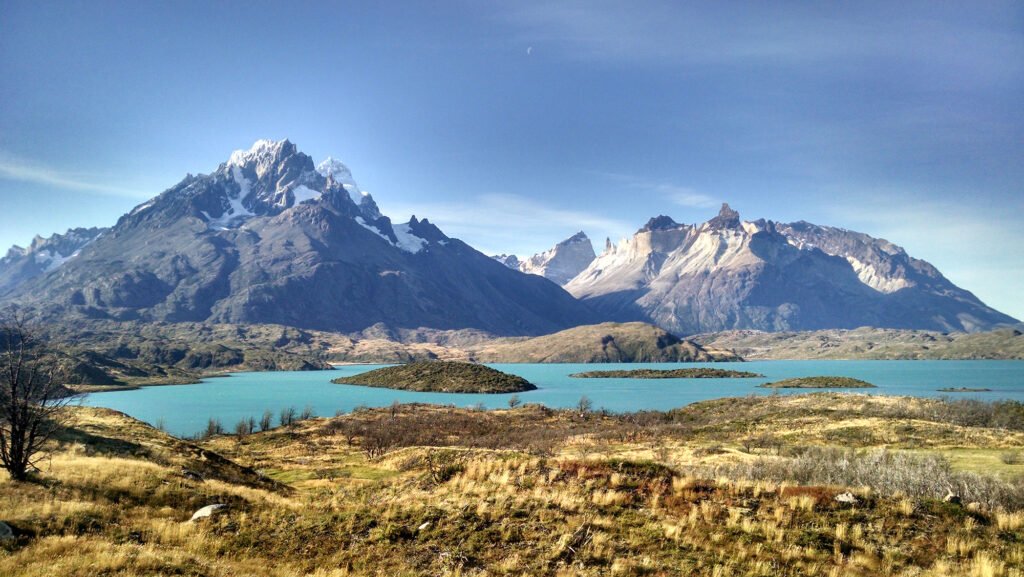
Food & Water for the W Trek
You will be able to buy food and drink at each of the refugios along the W Trek. However, this can get very expensive. We recommend that you try to be fully self-sufficient – and bring some extra cash to treat yourself on difficult days!
Food: You can stock up on food supplies from a supermarket in Puerto Natales, before departing to Torres del Paine National Park. Make sure to take a high-quality gas stove, gas canister, and mess kit.
Water: All campsites have access to fresh water sources to cook and refill your bottles. To avoid waterborne illness, we suggest that you use a water purification filter or water purification tablets before drinking this water.
5-Day Itinerary for Hiking the W Trek without a Guide
You will hike the W Trek one-way – meaning, it’s not a loop! You can choose to trek from either direction, east-to-west or west-to-easy. Each offers its own unique highlights:
- East-to-West: If you start from the east, your journey begins with a dramatic encounter with the famous Torres Del Paine, leaving you with diverse landscapes to explore.
- West-to-East: Opting for this direction allows you to save the magnificent towers for your grand finale while hiking through stunning valleys and forests.
The choice is yours, so customise your adventure to match your desires. The itinerary below is a sample 5-day itinerary for solo hiking the W Trek, from west-to-east. You can follow the plan below in reverse to do the trek from east-to-west, or make amendments to shorten or extend your total hike.
Please note that this itinerary provides an overview of the daily routes, but actual hiking times may vary based on your pace and trail conditions. Additionally, availability at refugios and campsites should be confirmed and booked in advance, especially during the peak trekking season. Enjoy your unforgettable journey through the stunning landscapes of Torres Del Paine!
Day 1 (Puerto Natales –> Refugio Grey)
- Total Kilometers: Approximately 11 km
- Estimated Time: 3-4 hours
- Start Point: Puerto Natales
- Finish Point: Grey
Begin your journey by catching the 7 am bus from Puerto Natales to Torres Del Paine National Park. This service will get you to the Leaving early will ensure you have enough time to hike and explore, without stressing about daylight.
Most buses that leave from Puerto Natales will stop:
- First at Laguna Amarga, where you get off if you plan on hiking the W Trek from east-to-west
- Second at Pudeto, where you get off if you plan on hiking the W Trek from west-to-east

Everyone will get off the bus at Laguna Amarga to show your entrance ticket for the park. You need to book your National Park permit online in advance. It is also advisable to download a copy of your ticket to your phone, as you are unlikely to have cell service in the park. If you are hiking the west-to-east route, you will then get back onto the bus to continue to Pudeto and Lake Pehoé.
When you get off the bus and Pudeto, stroll to the wharf. A catamaran service operated by Hipsur departs Pudeto for Paine Grande, transporting you for 30 minutes across Lake Pehoé to the start of your hike. The service departs at 9:30am, 10:30am, 4:15pm and 6:00pm over December to March. You should check their website for up-to-date operating times. The catamaran costs $25,000 pesos or $30 USD one-way, cash only. Tickets cannot be reserved in advance.
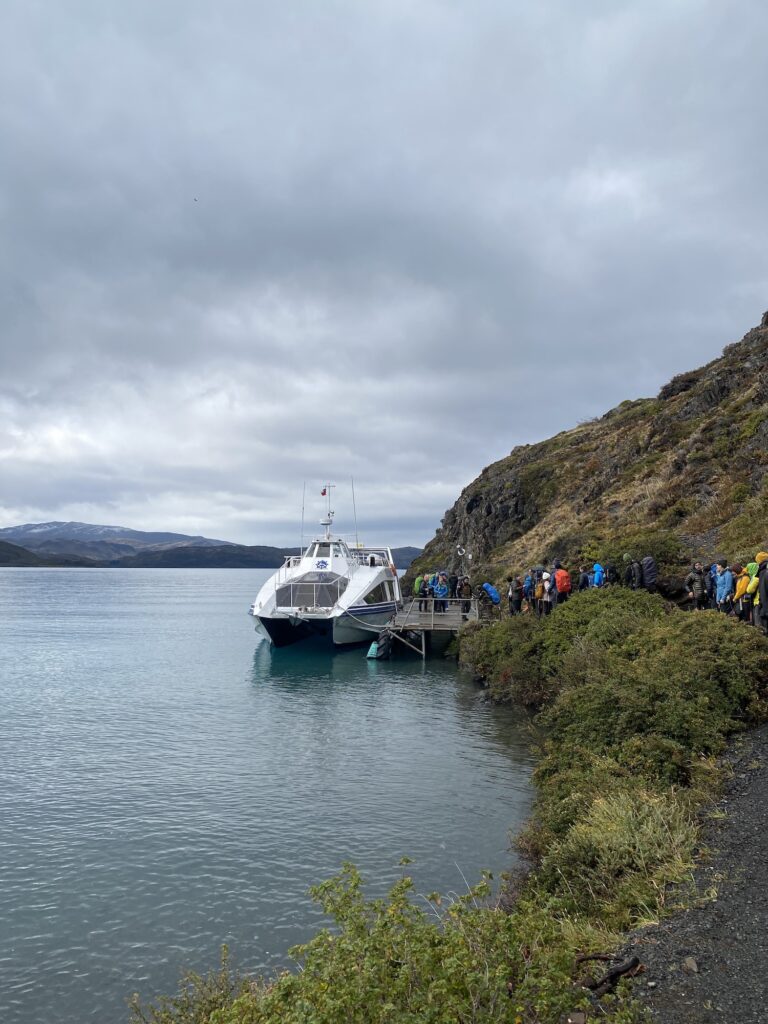
The hike to Grey Lodge is approximately 11 km and offers spectacular views of Lake Pehoé and the surrounding mountains. You’ll pass through enchanting forests and possibly catch a glimpse of local wildlife. Refugio Grey or Camping Grey is your destination for the night, offering stunning lakefront views. You should arrive in the early afternoon, so pitch your tent, meet some other hikers and cook dinner.
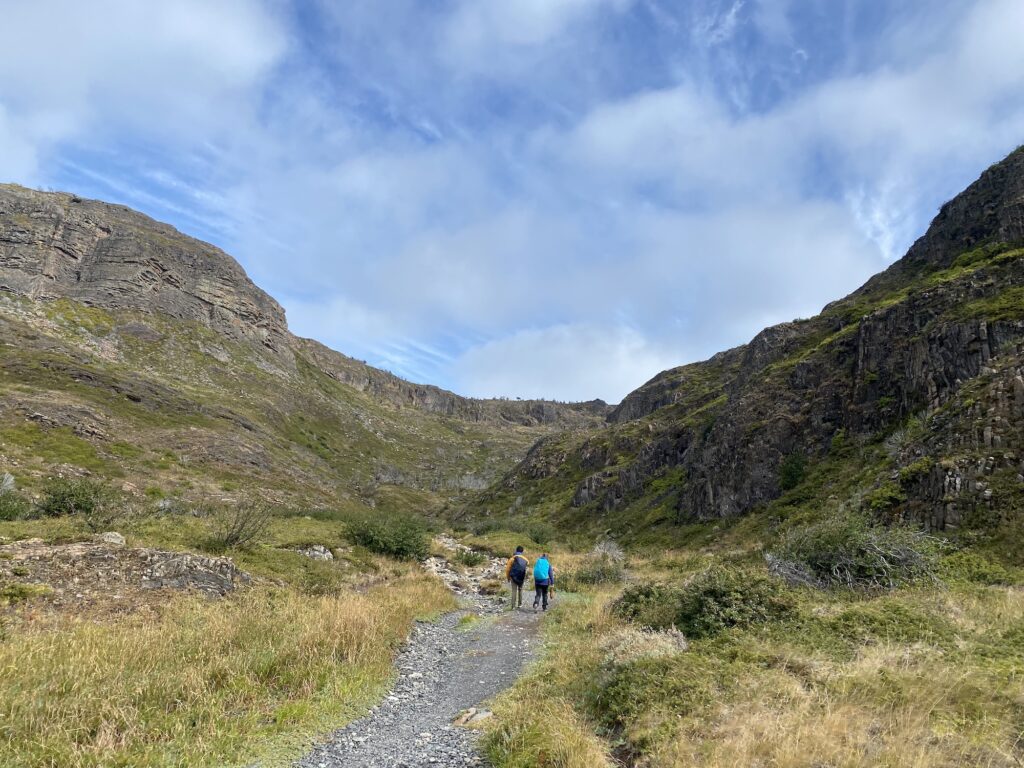
You can also choose to take an optional side trek, by continuing further north past the campsite. An extra 1 km through the forest will bring you to the snout of Grey Glacier, where you will have views of the enormous ice field. A further 2.5km along the path by the edge of the glacier will take you over a series of rope bridges with amazing views. This is about a 1hr round trip.
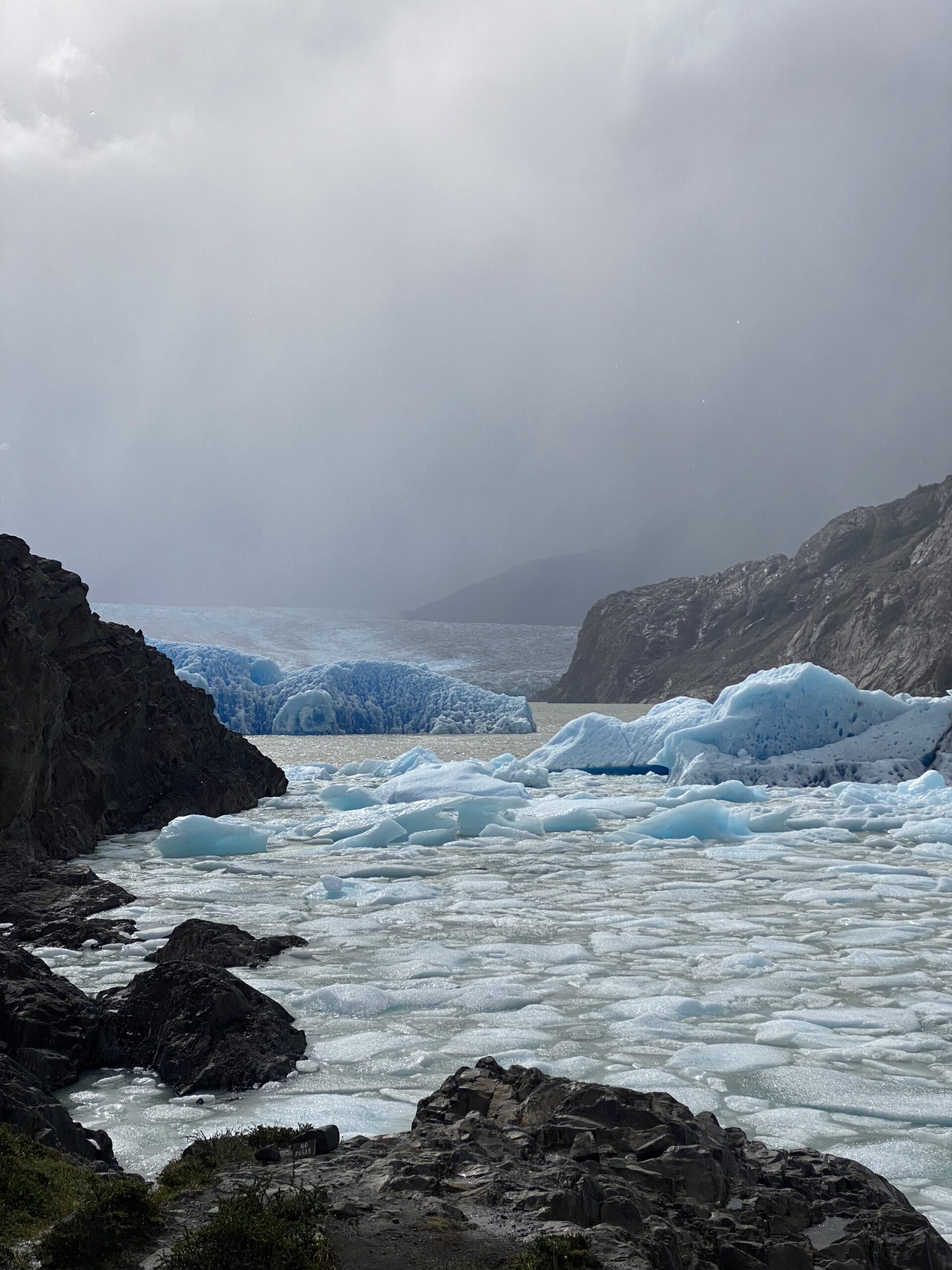
Day 2 (Grey –> Paine Grande)
- Total Kilometers: Approximately 11 km
- Estimated Time: 3-4 hours
- Start Point: Grey
- Finish Point: Paine Grande
Today, you’ll retrace your steps back to Paine Grande. The trail is mostly flat or downhill, making for a more relaxed walk. Along the way, you can choose to hike to the hanging bridges for an extra adventure.
Optional Add-On: Grey Glacier Ice Hike
One optional adventure you can undertake on the morning of Day 2 of the W Trek is an ice hike on Grey Glacier. Equipped with crampons and guided by experts, you can venture onto the glacier’s surface, exploring its captivating formations, deep blue crevasses, and surreal ice caves. This excursion provides an up-close encounter with the mesmerising world of glacial ice and a chance to witness the park’s natural wonders from a whole new perspective. It’s an unforgettable addition to your W Trek adventure for those seeking an extra dose of excitement and natural beauty.
Cost: The cost for the ice hike on Grey Glacier can vary, but it’s typically around $150 to $200 USD per person. This fee includes the necessary equipment such as crampons and the guidance of expert glacier guides.
Company: The ice hike on Grey Glacier is organised by Bigfoot Patagonia. This experienced tour provider ensures your safety and provides guidance throughout the excursion.
Duration: The ice hike adventure can take approximately 3 to 4 hours. This allows you to explore the glacier’s stunning features and take in the awe-inspiring surroundings.
Overnight Stay: To partake in the ice hike, it’s recommended to stay overnight at the Grey Lodge or campsite. This is because the ice hike usually takes place early in the morning to ensure the best ice conditions.
Adding the ice hike to your W Trek itinerary can be a memorable and thrilling way to connect with the glacial beauty of Torres Del Paine National Park.
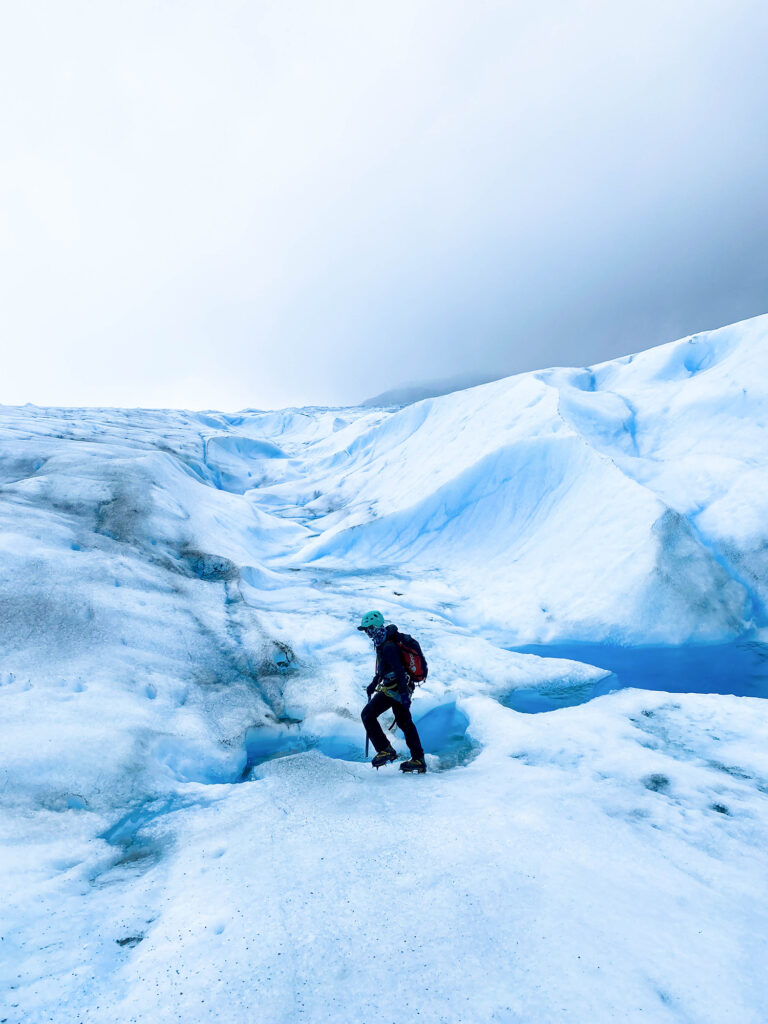
Day 3 (Paine Grande –> Francés/Los Cuernos)
- Total Kilometers: Approximately 21 km
- Estimated Time: 8-9 hours
- Start Point: Paine Grande
- Finish Point: Francés or Los Cuernos
This is a challenging day involving significant elevation gain, but it rewards you with some of the trek’s most stunning vistas. The trail takes you through valleys, along the shores of Lake Nordenskjöld to Guardería Italiano. You can leave your bags here with the ranger before hiking into the Francés Valley.
Hiking through the Francés Valley can vary greatly depending on the ever-changing Patagonian weather. This stretch of the hike marks the central segment of the W, and it’s a relentless uphill journey. After an hour of navigating steep and rocky terrain on a sometimes slippery trail, you’ll arrive at Mirador Francés, where you can catch sight of Glaciar Francés clinging to the western mountainside.
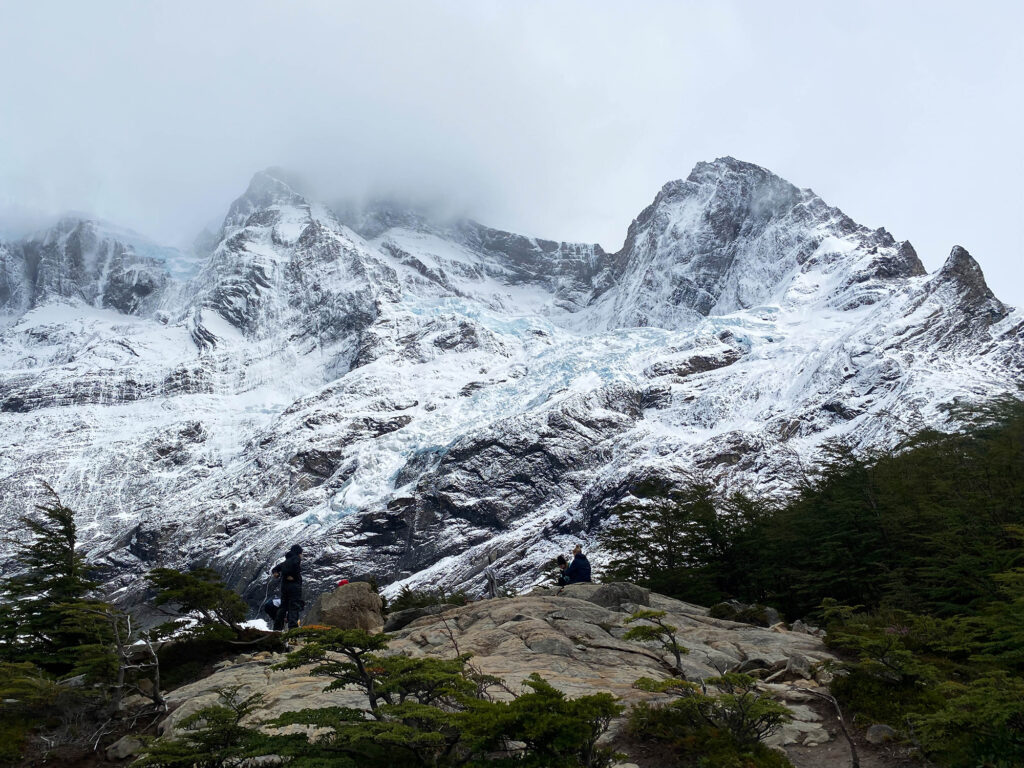
For those feeling especially adventurous and blessed with fair weather, there’s the option to continue ascending to Mirador Británico, adding an extra 3.5 kms each way, roughly three hours for the round trip. At Mirador Británico, you’ll be rewarded with panoramic views of a circle of jagged granite peaks, including the park’s second most famous landmark, the three-horned Cuernos del Paine. This spot ranks among the park’s most breathtaking viewpoints, particularly when the sky is clear. Keep a sharp eye out, as you might even spot the endangered Southern Andean huemul, a rare deer species, in this area.
Thankfully, the return journey is downhill as you make your way back to Campamento Italiano, where you can retrieve your backpack. Continue on for about 30 minutes to stay at Francés. If there is no availability at Francés, you can instead book to stay at Los Cuernos, which is a further 1 hour from Francés.

Day 4 (Francés/Los Cuernos –> El Chileno/Central)
- Total Kilometers: Approximately 15 km
- Estimated Time: 6-7 hours
- Start Point: Francés or Los Cuernos
- Finish Point: El Chileno or Central
The trail from Los Cuernos to El Chileno includes a steady elevation gain throughout the day. You’ll be treated to beautiful river and lake views along the way. As you approach El Chileno, you’ll be surrounded by lush Patagonian forests. Camping and refugio options are available for your overnight stay.

El Chileno is the ideal campsite for Day 4, as it is 4 kms from the Torres del Paine towers. This is important if you want to catch the sunrise at the viewpoint, so you don’t need to wake up so early! If you can’t get a booking at El Chileno, it is possible to hike from Central, but it is an additional 1hr and 45 minutes to reach the towers.
Day 5 (El Chileno/Central –> Torres del Paine –> Puerto Natales)
- Total Kilometers: Approximately 9 km (round trip to Mirador las Torres)
- Estimated Time: 5-6 hours (including time at the viewpoint)
- Start Point: Camping El Chileno or Refugio El Chileno
- Finish Point: Puerto Natales
Rise early to hike the trail to the famous Torres del Paine viewpoint. This is about 4km from El Chileno, meaning you should leave camp about 2hrs before dawn. If you are staying at Central, the hike is about 9km and you should leave camp about 4hrs before sunrise. Make sure you bring a head torch, as the rocky trail will be difficult in the dark. Expect the sun to rise around 7am – but be sure to check with the campground the night before your ascent.
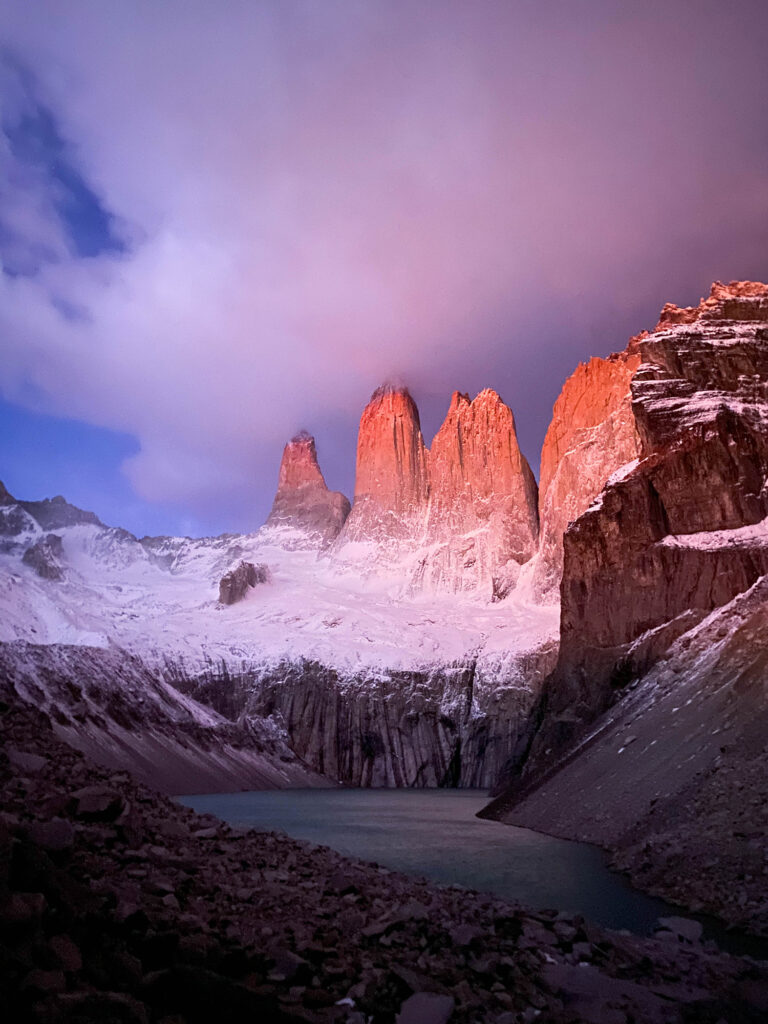
This challenging ascent is rewarded with breathtaking views of the iconic towers. After visiting the towers, descend to Hotel Las Torres. From here, you can take a shuttle bus back to Laguna Amarga for $3,000 pesos, cash only. This is where you get on a bus back to Puerto Natales, completing your W Trek adventure.
How Much Does it Cost to Hike the W Trek Without a Guide?
Before embarking on the W Trek in Torres Del Paine, it’s essential to have a clear understanding of the costs involved. This detailed cost breakdown will help you budget for your adventure effectively:
1. Park Entrance Fee – the park entrance fee for Torres Del Paine National Park varies depending on the season:
- High Season (November to March): Approximately $40 to $50 USD per person.
- Shoulder Season (Late October to early November, late March to early April): Around $20 to $30 USD per person.
- Low Season (April to September): Roughly $10 to $15 USD per person.
2. Transportation:
- Flights: The cost of flights to reach Teniente Julio Gallardo Airport (PNT) in Puerto Natales can vary widely based on your departure location. On average, round-trip flights from Santiago to PNT range from $150 to $300 USD.
- Buses: Bus tickets from Puerto Natales to the park entrance or various points within the park can cost approximately $20 to $50 USD round-trip. You can book tickets from the companies’ offices at the Puerto Natales bus station.
- Pudeto to Paine Grande Ferry: This ferry route is commonly used for the W Trek, and it crosses Lake Pehoé. The cost of the ferry ride can vary, but it was typically around $30 to $40 USD for a one-way ticket. The duration of the ferry ride is relatively short, approximately 30 minutes.
3. Accommodation:
- Camping: Camping fees at the park’s designated campsites typically range from $10 to $20 USD per person per night. These campsites are equipped with facilities such as bathrooms, showers, and cooking areas.
- Refugios: Staying in refugios offers more comfort but comes at a higher cost. The price per night in a refugio can vary between $60 and $150 USD per person, depending on the level of luxury and the time of year. This often includes meals.
4. Food:
- Self-Cooking: If you opt to prepare your meals, you can expect to spend approximately $10 to $20 USD per day on food. This estimate includes purchasing supplies in Puerto Natales before your trek.
- Meals at Refugios: Dining at refugios can be convenient, but it’s also more expensive. An average meal at a refugio restaurant can cost anywhere from $15 to $30 USD. Keep in mind that some refugio packages include meals.
5. Gear Rental:
- If you need to rent gear such as tents, sleeping bags, or hiking equipment, budget an additional $20 to $40 USD per day, depending on the items you require.
Please note that these cost estimates can vary based on individual preferences, the exchange rate, and any special promotions or discounts available at the time of booking. It’s advisable to check current prices and plan your budget accordingly to ensure a worry-free W Trek experience. Additionally, consider carrying some extra cash for unexpected expenses or emergencies during your journey.
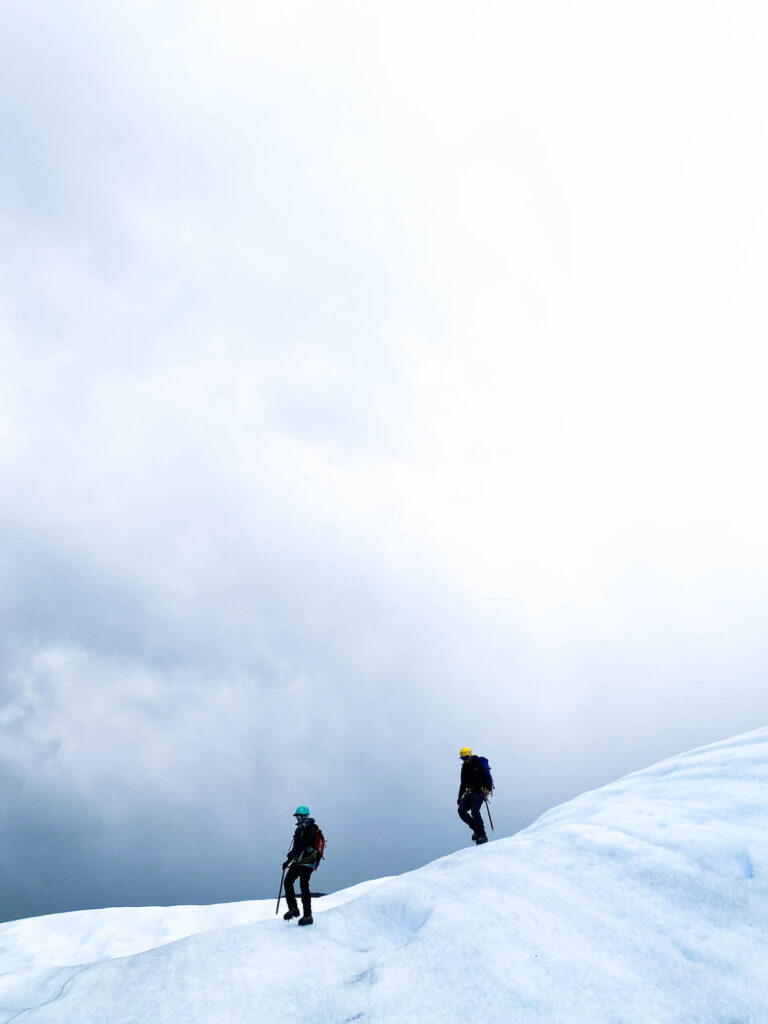
Hiking the W Trek Independently vs With a Guide
Deciding whether to embark on the W Trek independently or with a guide is a significant choice, and it largely depends on your preferences, experience, and what kind of adventure you seek. Below, we delve into the pros and cons of both options to assist you in making an informed decision:
Hiking Independently:
Pros:
- Flexibility: Independence grants you the freedom to set your pace, choose your daily itinerary, and make spontaneous decisions along the way. You have full control over your adventure.
- Cost-Effective: Independent trekkers often find it more budget-friendly, especially when it comes to accommodations. You can opt for camping and self-cooked meals to save money.
- Personal Connection with Nature: Solitude in the wilderness can provide a deeper connection with the natural surroundings and a more profound sense of adventure.
- Adventure of Self-Reliance: Successfully navigating the W Trek independently can be immensely rewarding, boosting your self-confidence and outdoor skills.
Cons:
- Logistical Challenges: Planning and booking accommodations, transportation, and permits can be time-consuming and occasionally frustrating, especially during peak seasons.
- Navigation: You must rely on your navigation skills and research to stay on the right path, which can be challenging in the ever-changing Patagonian weather.
- Safety Considerations: Solo travellers should be well-prepared for emergencies and have basic wilderness first aid knowledge.
Hiking the W Trek with a Guide
Pros:
- Expert Guidance: Guides are experienced and knowledgeable about the trail, local wildlife, and weather patterns. They can enhance your understanding and appreciation of the environment.
- Safety Assurance: With a guide, you have a safety net. They can provide assistance in emergencies, navigation, and first aid.
- Group Camaraderie: Joining a guided tour allows you to meet like-minded adventurers and share the experience, making it a social and potentially less solitary journey.
- Simplified Logistics: Many logistical aspects, such as accommodations and permits, are often handled by the guiding company, reducing your planning burden.
Cons:
- Cost: Guided tours can be more expensive due to the added services and expertise provided.
- Less Independence: Your schedule and daily activities are often predefined, leaving less room for spontaneity.
- Group Dynamics: Group tours may vary in size and composition, and you might not always have full control over the pace or itinerary.
In conclusion, the choice between hiking the W Trek independently or with a guide is a matter of personal preference and what aligns with your goals for the journey. Consider your budget, level of outdoor experience, desire for flexibility, and your comfort with navigating the trail. Both options offer unique advantages, and the W Trek promises an unforgettable adventure, regardless of the path you choose.

Trek Highlights and Scenic Spots
The W Trek in Torres Del Paine National Park is a visual symphony of natural wonders. Each leg of the journey unveils a new chapter in this captivating wilderness narrative. Here, we delve into the breathtaking highlights and scenic spots that await you:
1. Torres Del Paine – The Crown Jewels:
- Iconic Towers: No visit to Torres Del Paine is complete without witnessing the park’s namesake – the monumental Torres Del Paine. These three towering granite peaks, sculpted by the forces of nature, rise majestically against the Patagonian sky. The sight of the Torres, especially during sunrise or sunset, is a moment that etches itself into your memory forever.
2. Spectacular Valleys:
- French Valley (Valle del Francés): This emerald green valley enchants with its hanging glaciers, colossal rock faces, and panoramic vistas. Hiking through the French Valley feels like stepping into a postcard, surrounded by nature’s grandeur from every angle.
3. Lush Forests:
- Patagonian Wilderness: The W Trek meanders through pristine Patagonian forests, where moss-covered trees, vibrant lichens, and unique flora create a rich tapestry of greens. Walking amidst these ancient trees evokes a sense of timelessness.
4. Azure Lakes:
- Lago Pehoé and Lago Nordenskjöld: These crystal-clear lakes reflect the azure sky and surrounding peaks like mirrors. Their beauty is not only in the vibrant blue hues but also in the tranquility they offer. Pause by their shores and feel the serenity wash over you.
5. Glacier Grey:
- Glacial Majesty: Glacier Grey is a spectacle of ice and light. As you approach its shimmering blue face, you’ll be captivated by the sheer size and beauty of this ancient ice giant. The viewpoint offers an up-close encounter with one of Patagonia’s most remarkable glaciers.
6. Flora and Fauna Encounters:
- Wildlife: Keep a watchful eye for the diverse Patagonian wildlife. Guanacos, foxes, condors, and even the elusive puma inhabit these lands. Birdwatchers will be delighted by the variety of avian species that call this region home.
7. Mirador Cuernos:
- Cuernos Lookout: This viewpoint provides a mesmerising panorama of the iconic Cuernos del Paine, the horn-like peaks that define the landscape. It’s a place to pause, take in the surroundings, and appreciate the rugged beauty of Patagonia.
8. Southern Patagonian Ice Field:
- Distant Giants: While not part of the W Trek itself, the view of the Southern Patagonian Ice Field from certain points along the trail is awe-inspiring. Witness this vast expanse of ice, where countless glaciers originate, and feel the enormity of the natural forces at play.
The W Trek is a mesmerising journey through a pristine wilderness that will leave you humbled by nature’s artistry. Each of these highlights adds a unique stroke to the masterpiece that is Torres Del Paine National Park. Whether you’re an avid photographer, a nature enthusiast, or simply seeking serenity in the wild, the W Trek has something extraordinary to offer at every turn.
Booking the W Trek and Practical Information
Embarking on the W Trek adventure requires meticulous planning, from securing permits to arranging transportation. Here, we delve into the practical details you need to know to ensure a seamless journey through Torres Del Paine National Park:
1. Permits and Excursions:
- Booking Your Trek: The W Trek is in high demand, especially during the peak season (November to March). You must secure your accommodations and camping permits in advance. Remember that the campsites and refugios are operated by two different companies, Vertice and Fantastico Sur. Each has its own booking system, so it’s crucial to book dates that align with your itinerary. Start the booking process as early as possible, as securing the exact dates you need can be challenging.
- Excursions: If you’re interested in guided excursions or activities within the park, such as glacier hikes or boat trips, it’s advisable to book these in advance as well. This ensures you don’t miss out on the experiences that enhance your W Trek adventure.
2. Timetables for Buses and Park Entrance Tickets:
- Getting to Puerto Natales: To reach the starting point of the W Trek, you’ll likely fly into Santiago and then take a flight to Teniente Julio Gallardo Airport (PNT) in Puerto Natales. A 10-minute taxi ride will transport you from the airport to the downtown area, where most accommodations are situated. It’s recommended to spend a night in Puerto Natales to stock up on supplies before heading to the national park.
- Buses to the Park: From Puerto Natales, you’ll need to take a bus to Torres Del Paine. Various bus companies, such as Buses Fernandez, operate this route. Ensure you purchase your bus tickets in advance, particularly if you plan to catch an early morning departure. Timetables can vary, so check the schedules well in advance to align them with your trekking itinerary.
- Park Entrance Tickets: You’ll need to pay an entrance fee to access Torres Del Paine National Park. These tickets can be purchased at the park entrance or online. Having your entrance tickets ready in advance will save you time and streamline the process when you arrive.
3. Equipment and Supplies:
- Gear Checklist: Ensure you have all the necessary gear for your trek, including camping equipment, clothing layers, hiking boots, and more. Refer to the packing essentials section for a comprehensive checklist to make sure you’re well-prepared.
4. Safety and Emergency Contacts:
- Emergency Preparedness: While the W Trek is a stunning adventure, it’s essential to prioritise safety. Familiarise yourself with emergency contacts and park regulations before setting out. Have a plan for communication and emergency situations.
5. Accommodation Flexibility:
- Last-Minute Options: While booking accommodations in advance is wise, some refugios may have last-minute availability for hikers. Keep this in mind if your plans are flexible, but don’t rely on it entirely, especially during peak seasons.
Navigating the logistics of the W Trek ensures that your adventure unfolds smoothly, allowing you to focus on the awe-inspiring landscapes and experiences that await you. By planning ahead, you’ll maximise your enjoyment and make the most of your journey through the pristine wilderness of Torres Del Paine.
Conclusion
In conclusion, embarking on a solo adventure along the W Trek in Torres Del Paine, Chile, is a remarkable experience that will leave you with memories to last a lifetime. By planning carefully, packing smartly, and embracing the breathtaking beauty of Patagonia, you’ll embark on an unforgettable journey that showcases the very best of nature’s wonders.
FAQs
To hike the W in Torres del Paine, plan your itinerary, book accommodations, and obtain permits in advance. Start from either the east or west side, following well-marked trails and taking in the breathtaking landscapes along the way.
Yes, you can definitely hike the W Trek without a guide. Many solo hikers and groups explore the trail independently. The trail is well marked and sign-posted the whole route. Just be sure to plan and prepare well, including booking accommodations and permits in advance. If you are new to hiking and camping, consider hiking the W Trek with a guide or group.
No. Camping in Torres del Paine is restricted to designated campgrounds. This means there is no free camping. The purpose is to minimise the environmental impact and reduce the risk of fires, which have previously ravaged significant portions of the park, covering approximately 17,000 hectares (41,000 acres) or 7% of its total area.
The duration of the W Trek can vary depending on your pace and itinerary. On average, hikers complete the W circuit in 4 to 6 days. It’s a flexible trek that allows you to choose your route and pace.
While it’s technically possible to complete the W Trek in 4 days, it would be a very strenuous and rushed experience. Most hikers opt for a 5-day itinerary to fully enjoy the trek and its stunning landscapes. A 4-day trek would require covering significant distances each day.
The difficulty of the W Trek varies, but it’s generally considered a moderate hike. It involves steep ascents and descents, variable weather conditions, and covering significant distances. Being physically prepared and having the right gear is essential.
To start the W Trek, you’ll typically fly to Santiago, then catch a flight to Puerto Natales, the gateway to Torres Del Paine National Park. Spend a night in Puerto Natales to stock up on supplies before heading to the park.
Charging facilities are available at some refugios and campsites along the W Trek, but they may be limited. It’s advisable to bring a portable power bank to ensure you can keep your devices charged throughout the trek.
The best months to hike Torres del Paine are during the shoulder seasons of late October to early November and late March to early April. These periods offer milder weather and fewer crowds. However, if you prefer vibrant spring or summer landscapes, consider the peak season from November to March.
Absolutely! The W Trek is worth it for its stunning natural beauty, iconic landmarks like Torres Del Paine, and the sense of adventure it offers. It’s a memorable experience for nature enthusiasts and hikers.
Yes, you can find water sources along the W Trek route. It’s essential to bring a water purification filter or water purification tablets to ensure the water is safe to drink from streams and rivers.
For the W Trek, it’s essential to bring lightweight, high-energy, and non-perishable foods. Consider items like energy bars, nuts, dried fruits, instant oats, pasta, dehydrated meals, and freeze-dried options. Make sure to pack foods that are easy to prepare on camping stoves and provide the necessary nutrition for your journey. Additionally, you can purchase some supplies at refugios along the trail if needed.
While some places in Torres del Paine accept credit cards, it’s advisable to carry some cash. Cash can be useful in case you encounter places that don’t have card payment facilities, or when reception in the park is not working. You will also need cash for the boat from Pudeto to Paine Grande.
Yes. There are well-maintained toilets at each campsite along the W Trek.
Torres del Paine can be relatively expensive due to park entrance fees, accommodation costs (especially in refugios), and dining options. However, there are ways to manage costs, such as camping and preparing your own meals if you’re on a budget.
Some of the best parts of the W Trek include witnessing the iconic Torres Del Paine towers, exploring spectacular valleys, hiking through lush forests, and marveling at crystal-clear lakes that dot the landscape.
